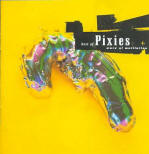This review was first
published on CLUAS in 2004
Other albums reviewed in 2004
The Pixies
A review of their 'best of' album 'Wave of Mutilation'
Usually seeing "Best Of" albums as a bid to revive flagging interest and make more money, I was sceptical in approaching this one. However, every once in a blue moon, there emerges from the ashes of a band's career a greatest hits album that truly celebrates what the group once was, and in all probability still is. This is just such a CD - a demonstration of the Pixies' musical progression, a tour de force of changing moods and rocking songs.
 From the opener Bone Machine (Surfer Rosa, 1988) you are sucked into the
world of alt. rockers the Pixies. Finally the younger generation are being
introduced to the band that played such a huge role in the resurgence of
alternative rock and pop in the late 80s and early 90s. The album then launches straight into the hits
from the band's first album, Come On Pilgrim (1987). The rambling relaxed
sounds, especially in Holiday Song and Caribou, clash with the obvious feelings
of frustration hidden in the abstract lyrics. These are the songs Frank Black
(previously Black Francis, occasionally Francis Thompson, once Black Angel, or
more formally Charles Michael Kitridge Thompson IV) is obviously looking back on
with Frank Black and the Catholics, albeit with more cheer.
From the opener Bone Machine (Surfer Rosa, 1988) you are sucked into the
world of alt. rockers the Pixies. Finally the younger generation are being
introduced to the band that played such a huge role in the resurgence of
alternative rock and pop in the late 80s and early 90s. The album then launches straight into the hits
from the band's first album, Come On Pilgrim (1987). The rambling relaxed
sounds, especially in Holiday Song and Caribou, clash with the obvious feelings
of frustration hidden in the abstract lyrics. These are the songs Frank Black
(previously Black Francis, occasionally Francis Thompson, once Black Angel, or
more formally Charles Michael Kitridge Thompson IV) is obviously looking back on
with Frank Black and the Catholics, albeit with more cheer.
However the band seems to find their freedom as the huge personalities of Gigantic and Broken Face (both from Surfer Rosa) set the sound for a more fun and experimentation-loving Pixies. These few songs mark the beginning of a new era of experimentation for the Pixies, with stricter song structures and greater concentration on instruments. The vocal style also changes, with new minor harmonies coming in to contrast the somewhat happy sounding vocals.
Next it is to the best known of their five albums, tracks of which take up nearly a third of the CD: the epic Doolittle (1989). From a simple Hey to a screaming Tame, the Pixies demonstrate yet another new side: darker, heavier with more bass-driven yet melodic tunes. The contrasting upbeat tunes with downright downcast lyrics still give the music the edge that keeps you hooked and intrigued. Even at their most pop (e.g. Here Comes Your Man) nothing is ever too sweet. Nonetheless the band has still maintained their sense of the mad and humorous with Monkey Gone to Heaven. Bossanova (1990) paints quite a different picture of the band. In the intervening year, the Pixies seem to have settled into themselves, apparently worrying less about their image (if indeed they ever did). They play as they like, finally admitting the influences of classic rock artists and growing a little more eccentric. This feeling persists throughout the final three songs, including the fast and furious Alec Eiffel, from Trompe de Monde. This was the bands fatal album, and the mark of a band who had done all they were here to do.
So from the despondency of Come on Pilgrim, through the disfigurement of
Doolittle to the inevitability of Trompe de Monde, the Pixies sent a wave that
mutilated the face of popular music forever. However, destruction breeds
creation, and the pieces have come together as a work of art. The legacy of the
Pixies will live on.
Anna Murray
